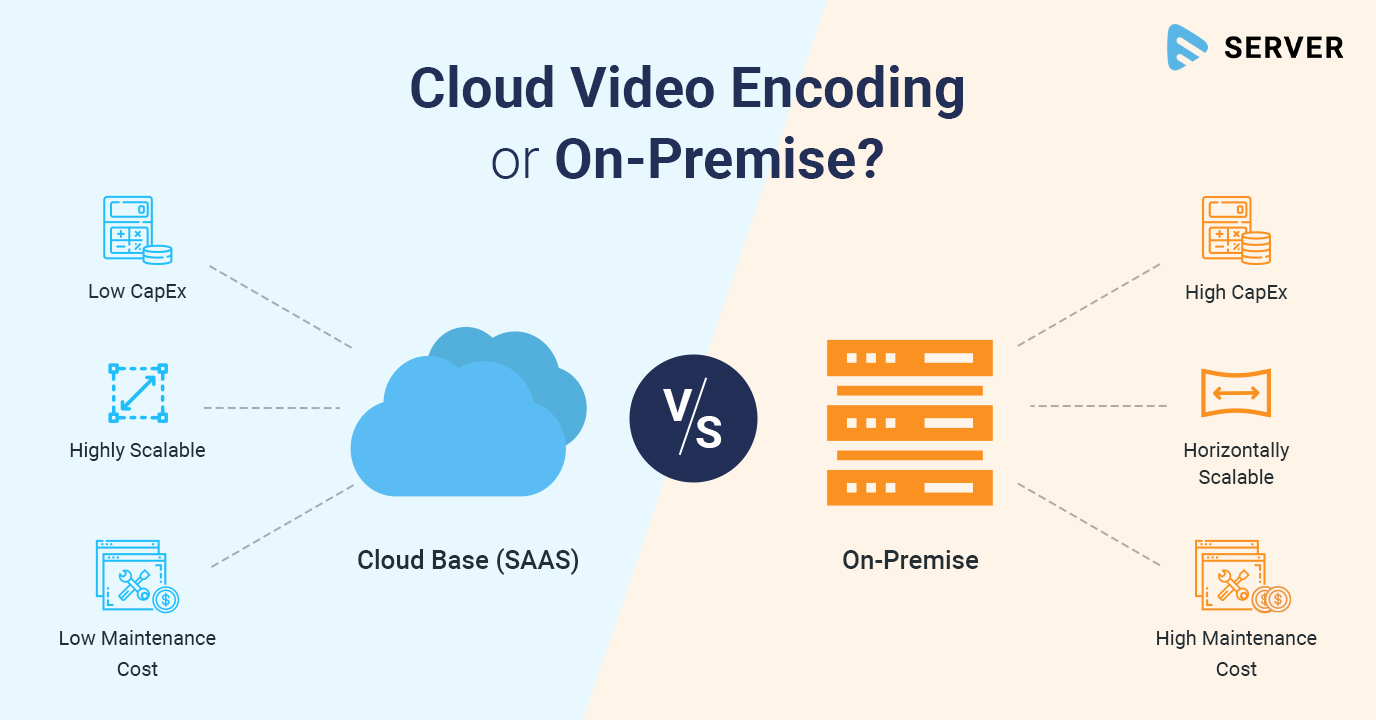Customers nowadays, rightfully demand a 360° user-experience when it comes to video streaming. This includes a user-friendly interface, easy content discovery options, and of course, streaming low latency buffer-free videos. To meet such high streaming standards, now, more than ever, individual content providers, start-ups and enterprise companies have started to realize the importance of scalable cloud hosting infrastructure and its irreplaceable role in buffer-free streaming.
Costs, infrastructure, and a lot of other factors come into play before one can decide to opt for a cloud video encoding infrastructure or narrow down on an in-house service. It’s essential to evaluate the pros and cons of each before stepping in, as it can lead to customer churn resulting in loss of revenue.
To help you solve the dilemma, we have compiled all the essential information you would need to decide upon the right media server between cloud and on-premise and which one is apt for your business.
On-Premise Encoding
On-premise encoding is a process where content providers can encode and package video locally on their own hardware. Implementation of this process requires the installation and maintenance of encoding software and a dedicated server farm. Also, one must hire a highly skilled IT workforce for the purpose.
Pros-
- More security- Critical data is stored on-premise with no third party access.
- Control over data and content- You decide on the configuration, the upgrades, and system changes.
- Uptime – You do not rely on internet connectivity or external factors to access your software.
Cons-
- Requires a considerable amount of expense in terms of deployment, hardware, and infrastructure.
- Physical space and dedicated IT support is needed for operating in-house servers.
Cloud Video Encoding
In a cloud computing environment, encoding/transcoding is carried out by the power of the cloud. Cloud video encoding converts video files to make them viewable by any media players, devices, or web browsers and operating systems, without any storage liabilities.
You can encode videos fast and reach a multitude of Internet-connected devices without investing in costly infrastructure. Transcoding in the cloud scales instantly according to demand, giving you the power of large encoding clusters without burning a hole in your pocket.
Pros-
- More cost-effective – No upfront investment required
- More accessible – You can access your data anytime and anywhere via a web browser from any device.
- Quick deployment – Cloud-based software is deployed over the Internet in a matter of hours/days
- Infinite scalability – You can scale as you face more traffic spikes on-the-fly
Cons-
- The user experience is limited by the speed of the internet connection.
- Third-party cloud servers can have direct access to your data.
Cloud vs On-Premise: Encoding and Scalability
Cloud Environments
As a VoD channel owner, you are challenged to meet unexpected traffic spikes without sacrificing the user experience. With a cloud server, you can customize your capacity on-demand in the public cloud. You can scale VoD content as your data volumes increase or dial down capacity as and when necessary.
This makes it a more cost-effective process in the long run as you follow the pay-as-you-go model rather than investing a huge CapEx in the more traditional in-house video encoding techniques.
Moving encoding/transcoding into the cloud helps content creators to free themselves up from the task of maintaining a dedicated encoding server farm that ultimately leads to a reduced CapEx in purchasing and renewing hardware/software. Also, operating expenditures associated with running such a platform—that includes, but not limited to electricity, floor space, and technical support are eliminated.
On-premise Server
As far as scalability is concerned, on-premises generally scale horizontally; server administrators have to add another server node to an already existing cluster. In this case, the main disadvantage is that the software has to be capable of handling all the data distribution, and the parallel processing complexities.
Traditional on-premise hardware servers can be costly and may not be equipped to manage modern applications as technology continues to evolve. Also, on-premise servers demand regular maintenance including component replacements and upgrades, damage protection, location security, network troubleshooting, and staff system administration.
However, one may assume that after having the server farm up and running, it might be less costly to go for in-house encoding than paying a third-party to do it for you. But that equipment has a limited lifespan, and the base of formats it has to serve keeps changing and expanding.
Video Encoding and Security
Security becomes a major issue as far as video encoding/transcoding in the cloud is concerned, especially when you have to deal with original and intellectual property like video and audio content. Needless to say, once you delegate your content to a third-party cloud server and take it off your server farm, you lose a certain degree of control.
But that does not make cloud encoding unsafe, either. Since the cloud is more distributed in architecture accompanied by variable hardware locations, it is less vulnerable to being hacked. With the right architecture, auditing, and network-level security, the cloud is at par with its on-premise counterpart as far as security is concerned.
Final Thoughts
Given the bright spots such as instant deployability, resilient workflow, service redundancy, and infinite scaling possibilities, the cloud is the future of content encoding/transcoding and distribution. In fact, cloud computing is constantly growing in size and capabilities, and as it grows, the cost associated with declines in comparison to in-house server farm costs. Also, thanks to the increasing bandwidth speeds of cloud servers, the problem of bottlenecks experienced by large file transfers is slowly becoming a myth.
Built in the cloud, Muvi Server offers a stable, secure, and ultra low latency video streaming experience minus the heavy CapEx. Driven by adaptive media and chunked delivery concept, Muvi Server streamlines encoding multi-format & multi-device content and delivery curbing bandwidth consumption while ensuring a superior user experience.
Take a 14-Day Free Trial to explore more cloud encoding possibilities!













Add your comment